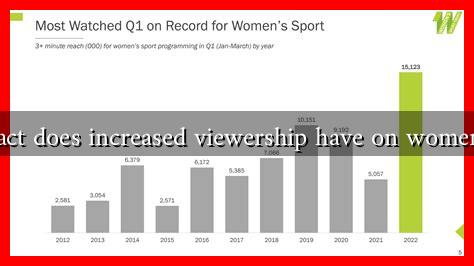-
Table of Contents
What Impact Does Increased Viewership Have on Women in Sports?
The landscape of sports has undergone a significant transformation in recent years, particularly concerning women’s sports. As viewership for women’s events continues to rise, the implications for female athletes, teams, and the broader sports community are profound. This article explores the multifaceted impact of increased viewership on women in sports, highlighting the benefits, challenges, and future prospects.
The Rise of Women’s Sports Viewership
Increased viewership of women’s sports is not merely a trend; it reflects a growing recognition of female athletes’ talent and the importance of gender equity in sports. Several factors contribute to this rise:
- Media Coverage: Major networks are dedicating more airtime to women’s sports, showcasing events like the Women’s World Cup and the WNBA Finals.
- Social Media Influence: Platforms like Instagram and Twitter allow female athletes to connect with fans, share their stories, and promote their sports.
- Increased Investment: Sponsorship deals and funding for women’s leagues have surged, leading to better marketing and visibility.
According to a report by Nielsen, women’s sports viewership increased by 54% from 2019 to 2021, indicating a significant shift in audience engagement.
Positive Impacts of Increased Viewership
The rise in viewership has several positive implications for women in sports:
- Increased Funding: Higher viewership translates to greater advertising revenue, which can lead to increased funding for women’s teams and leagues. For instance, the U.S. Women’s National Soccer Team (USWNT) has seen a surge in sponsorship deals following their success in the FIFA Women’s World Cup.
- Enhanced Visibility: More viewers mean more exposure for female athletes, which can inspire young girls to pursue sports. The visibility of role models like Serena Williams and Megan Rapinoe encourages participation at grassroots levels.
- Improved Pay Equity: As viewership grows, so does the argument for pay equity. The USWNT’s fight for equal pay has gained traction, with increased viewership serving as a powerful argument for their case.
Challenges Faced Despite Increased Viewership
While the rise in viewership presents numerous benefits, challenges remain:
- Media Representation: Despite increased coverage, women’s sports still receive less media attention than men’s sports. A study by the Women’s Sports Foundation found that only 4% of sports media coverage is dedicated to women’s sports.
- Gender Stereotypes: Female athletes often face stereotypes that can undermine their achievements. The media sometimes focuses on their appearance rather than their athletic performance, which can detract from their accomplishments.
- Inconsistent Support: Viewership can fluctuate, and sustaining interest in women’s sports requires ongoing investment and promotion. Events like the Women’s NCAA Basketball Tournament have seen spikes in viewership, but maintaining that momentum is crucial.
Case Studies: Success Stories in Women’s Sports
Several case studies illustrate the positive impact of increased viewership on women’s sports:
- FIFA Women’s World Cup: The 2019 tournament saw a record 1.12 billion viewers, leading to increased sponsorship and a push for better pay for female players.
- WNBA: The league has experienced a 68% increase in viewership over the past few years, prompting teams to secure lucrative sponsorship deals and expand their fan base.
- Women’s Tennis Association (WTA): The WTA has seen a rise in viewership and sponsorship, particularly during major tournaments like Wimbledon and the US Open, where female athletes are celebrated for their skills and achievements.
Conclusion: A Promising Future for Women in Sports
The increased viewership of women’s sports is a powerful catalyst for change, fostering greater visibility, funding, and support for female athletes. While challenges remain, the momentum generated by rising viewership offers a promising future for women in sports. As audiences continue to engage with women’s events, the potential for growth and equity in the sports industry becomes increasingly attainable. By supporting women’s sports, we not only uplift female athletes but also contribute to a more inclusive and equitable sporting world.
For more insights on women’s sports and their impact, visit the Women’s Sports Foundation.




